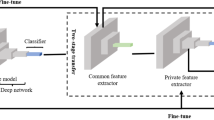Abstract
At present, Trojan traffic detection technology based on machine learning generally needs a large number of traffic samples as the training set. In the real network environment, in the face of Zero-Day attack and Trojan variant technology, we may only get a small number of traffic samples in a short time, which can not meet the training requirements of the model. To solve this problem, this paper proposes a method of Trojan traffic detection using meta-learning for the first time, which mainly includes the embedded part and the relation part. In the embedding part, we design a neural network combining ResNet and BiLSTM to transform the original traffic into eigenvectors and allocate the meta tasks of each round of training in the form of a C-way K-shot. In the relation part, we design a relationship network improved by dynamic routing algorithm to calculate the relationship score between samples and categories in the meta-task. The model can learn the ability to calculate the difference between different types of samples on multiple meta-tasks. The model can use a small number of samples to complete training and classify quickly according to prior knowledge. In few-shot, our method has better results in Trojan traffic classification than the traditional deep learning method.
Access this chapter
Tax calculation will be finalised at checkout
Purchases are for personal use only
Similar content being viewed by others
References
He, K., Zhang, X., Ren, S., et al.: Deep residual learning for image recognition. In: Proceedings of the IEEE Conference on Computer Vision and Pattern Recognition, pp. 770–778 (2016)
Moore, A.W., Zuev, D.: Discriminators for use in flow-based classification. Technical report, Intel Research, Cambridge (2005)
Feizollah, A., Anuar, N.B., Salleh, R., et al.: Comparative study of k-means and mini batch k-means clustering algorithms in android malware detection using network traffic analysis. In: 2014 International Symposium on Biometrics and Security Technologies (ISBAST), pp. 193–197. IEEE (2014)
Rezaei, S., Liu, X.: Deep learning for encrypted traffic classification: an overview. IEEE Commun. Mag. 57(5), 76–81 (2019)
Wang, W., Zhu, M., Zeng, X., et al.: Malware traffic classification using convolutional neural network for representation learning. In: 2017 International Conference on Information Networking (ICOIN), pp. 712–717. IEEE (2017)
Wang, W., Zhu, M., Wang, J., et al.: End-to-end encrypted traffic classification with one-dimensional convolution neural networks. In: 2017 IEEE International Conference on Intelligence and Security Informatics (ISI), pp. 43–48. IEEE (2017)
Wang, W., Sheng, Y., Wang, J., et al.: HAST-IDS: learning hierarchical spatial-temporal features using deep neural networks to improve intrusion detection. IEEE Access 6, 1792–1806 (2017)
Hwang, R.H., Peng, M.C., Nguyen, V.L., et al.: An LSTM-based deep learning approach for classifying malicious traffic at the packet level. Appl. Sci. 9(16), 3414 (2019)
Liu, X., You, J., Wu, Y., et al.: Attention-based bidirectional GRU networks for efficient HTTPS traffic classification. Inf. Sci. 541, 297–315 (2020)
Santoro, A., Bartunov, S., Botvinick, M., et al.: One-shot learning with memory-augmented neural networks. arXiv preprint arXiv:1605.06065 (2016)
Munkhdalai, T., Yu, H.: Meta networks. In: Proceedings of the 34th International Conference on Machine Learning, vol. 70, pp. 2554–2563. JMLR. org (2017)
Ravi, S., Larochelle, H.: Optimization as a model for few-shot learning. In: International Conference on Learning Representations (2017)
Koch, G., Zemel, R., Salakhutdinov, R.: Siamese neural networks for one-shot image recognition. In: ICML Deep Learning Workshop, p. 2 (2015)
Sung, F., Yang, Y., Zhang, L., et al.: Learning to compare: Relation network for few-shot learning. In: Proceedings of the IEEE Conference on Computer Vision and Pattern Recognition, pp. 1199–1208 (2018)
Xu, C., Shen, J., Du, X.: A method of few-shot network intrusion detection based on meta-learning framework. IEEE Trans. Inf. Forensics Secur. PP(99), 1 (2020)
Zhenyan, L., Yifei, Z., Pengfei, Z., et al.: An imbalanced malicious domains detection method based on passive DNS traffic analysis. Secur. Commun. . 2018, 1–7 (2018)
Sabour, S., Frosst, N., Hinton, G.E.: Dynamic routing between capsules. In: Advances in neural Information Processing Systems, pp. 3856–3866 (2017)
Mandal, B., Ghosh, S., Sarkhel, R., et al.: Using dynamic routing to extract intermediate features for developing scalable capsule networks. In: 2019 Second International Conference on Advanced Computational and Communication Paradigms (ICACCP), pp. 1–6. IEEE (2019)
Lin, A., Li, J., Ma, Z.: On learning and learned data representation by capsule networks. IEEE Access 7, 50808–50822 (2019)
Li, S., Yun, X., Zhang, Y., Xiao, J., Wang, Y.: A general framework of trojan communication detection based on network traces. In: IEEE Seventh International Conference on Networking Architecture and Storage, pp. 49–58 (2012)
Jiang, D., Omote, K.: An approach to detect remote access trojan in the early stage of communication. In: 2015 IEEE 29th International Conference on Advanced Information Networking and Applications, Gwangiu, pp. 706–713 (2015). https://doi.org/10.1109/AINA.2015.257
Acknowledgement
This research is supported by the National Key Research and Development Program of China (Grant No. 2018YFC0824801). It is also partially supported by Key Laboratory of Network Assessment Technology, Chinese Academy of Sciences and Beijing Key Laboratory of Network Security and Protection Technology.
Author information
Authors and Affiliations
Corresponding author
Editor information
Editors and Affiliations
Rights and permissions
Copyright information
© 2021 Springer Nature Switzerland AG
About this paper
Cite this paper
Jia, Z., Yao, Y., Wang, Q., Wang, X., Liu, B., Jiang, Z. (2021). Trojan Traffic Detection Based on Meta-learning. In: Paszynski, M., Kranzlmüller, D., Krzhizhanovskaya, V.V., Dongarra, J.J., Sloot, P.M.A. (eds) Computational Science – ICCS 2021. ICCS 2021. Lecture Notes in Computer Science(), vol 12743. Springer, Cham. https://doi.org/10.1007/978-3-030-77964-1_14
Download citation
DOI: https://doi.org/10.1007/978-3-030-77964-1_14
Published:
Publisher Name: Springer, Cham
Print ISBN: 978-3-030-77963-4
Online ISBN: 978-3-030-77964-1
eBook Packages: Computer ScienceComputer Science (R0)




